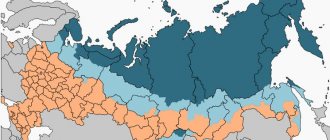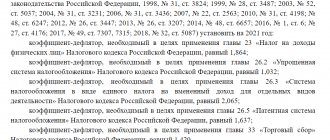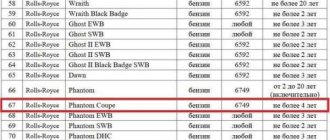The increasing regional coefficient is an indicator by which the wages of employees working in difficult climatic conditions are recalculated. In accordance with Articles 146, 148 and 316 of the Labor Code of the Russian Federation, the income of workers employed at enterprises located in regions with an unfavorable climate must be multiplied by a certain multiplier, which is equal to the value of the regional coefficient established for the region.
Regional coefficients in the Labor Code
The Labor Code of the Russian Federation defines the regional coefficient as a mechanism for equalizing workers' incomes through an increasing financial indicator that indexes payments in regions with special climatic conditions and equivalent ones.
This method of government support for working citizens operates at the government and local level.
The Labor Code of the Russian Federation and other legislative acts prescribe this norm in the following provisions:
- Art. 316 of the Labor Code says that regional indexing coefficients are set directly by the Government of the Russian Federation, which does not exclude the possibility of additional “additions” from local budgets;
- Art. 146, art. 148 Labor Codes decipher in detail the concept of RK as a state-guaranteed supplement to various types of payments for working citizens;
- the territories in which the fixed RK will be relevant are given in Resolution of the Ministry of Labor dated September 11, 1995 No. 49;
- Art. 10 of Federal Law N 4520-1 of February 19, 1993 covers in detail the “northern” allowances.
Question: Is the regional coefficient applied to the wages of employees of separate divisions in Novosibirsk and Khabarovsk and are they provided with additional vacation days if the organization is located in Moscow? View answer
Ural coefficient
For residents of the Urals, a regional Ural coefficient has been established since November 1987. It applies to the wages of residents of the Urals. The Labor Code establishes that the Government of the Russian Federation approves the coefficients, but today there is no such law that would provide for the regions in which the coefficient is established, as well as the size of the coefficient. Therefore, those regulations that were adopted by government agencies of the constituent entities of the Russian Federation on the basis of the legislation of the USSR are in force to this day.
Thus, as of 2021, the obligation to accrue the Ural coefficient on employee salaries remained with employers in the cities of the Urals (
Who can qualify for regional surcharges?
Funds, taking into account the regional coefficient, will be received as government-guaranteed payments by employees living and working in the regions provided for by law, regardless of the form of ownership of the organization. Features of the region that determine the purpose of the Republic of Kazakhstan:
- dependence on transport;
- existing infrastructure;
- environmental conditions;
- climate;
- sphere of operation of the enterprise.
IMPORTANT! The regional coefficient applies to all employees working on the basis of an employment contract, without exception, from the very first working day - subject to the essential condition of their permanent residence or employment in the specified territories.
Areas with a status requiring financial equalization include the following territories of the Russian Federation:
- the southern part of the East Siberian region;
- Far East;
- The Far North and regions similar in status to it.
Question: An organization located in the Far North pays bonuses for anniversaries in the organization and for a professional holiday. The payment of bonuses is specified in the collective agreement. Are regional coefficients and northern allowances applied to these premiums? View answer
Prospects for existence: will bonuses be canceled or left in place?
At the end of 2014, the Ministry of Labor of the Russian Federation raised the issue of reviewing the current state of affairs. The system of incentives for the population bearing the hardships of a harsh climate, created during the Soviet era, requires revision to meet the realities of modern life and the difficult economic situation. One of the main arguments put forward against the existence of northern surcharges is the extra burden on business. In the private sphere, the employer offers a certain amount of remuneration, from which the accounting department “artificially” separates out the salary and compensating additional payments.
On March 30, 2015, the law on the creation of priority development areas, priority development areas that provide preferential treatment for enterprises, came into force. For 3 years, until March 2021, the law allows the creation of such territories exclusively in the Far East and in single-industry towns, then throughout the country.
The TOP provides for the release of the employer from the obligation to pay SN and RK, subject to a number of conditions:
- SN and RK can be replaced by payment of monetary compensation, which should be reflected in a collective agreement or industry agreement;
- The amount of compensation and the calculation procedure are also determined by the collective agreement;
- Replacement is not possible without the voluntary written consent of the employee;
- The final remuneration for work must exceed the subsistence minimum established by the constituent entity of Russia.
These provisions of the law are valid only for individual entrepreneurs and privately owned organizations, and do not apply to government agencies and municipal organizations.
On the eve of the upcoming election cycle: 2021 - State Duma elections, 2021 - Presidential elections, the authorities are unlikely to take unpopular radical measures. However, the law on priority development territories is a step towards the abolition of benefits in their traditional sense.
Payments indexed by the Republic of Kazakhstan
The law provides a list of financial income that is subject to the obligation to apply the district allowance:
- the minimum amount of labor remuneration and, accordingly, all payments “tied” to the minimum wage;
- salary, tariff rate, wages themselves - the entire amount received by the employee;
- all additional payments to labor remuneration - compensation, bonuses, allowances for length of service, for qualifications, for military or commercial secrets, etc.;
- surcharge “for harmfulness”;
- compensation for temporary disability;
- remuneration for seasonal workers, part-time workers, flexible or part-time workers;
- pension accruals;
- other funds paid on the basis of an employment or collective agreement.
NOTE! Pensioners will receive increased amounts only as long as they live in “special” territories; moving will necessarily remove the regional indexation of pensions.
Systematization of accounting
If the internal local acts of the organization (charter, collective agreement, labor agreement, bonus regulations) stipulate that the bonus additional payment is included in the salary, then the RK is accrued on it in any case. This applies to both quarterly bonuses, paid every three months, and annual bonuses, accrued at the end of the year. This rule applies to all regions in which the increasing multiplier operates.
- The employee's insurance period at the time of provision of sick leave is no more than six months.
- The average monthly salary of an employee for the previous two years is less than the legally established minimum wage.
- The employee was not paid wages for two years (due to lack of work activity).
- A violation of the employee’s prescribed treatment regimen was discovered.
- The insured event occurred due to the employee’s drunken state.
These payments are not covered by the Republic of Kazakhstan
For logical reasons, the coefficient does not apply to the following cash accruals in favor of employees:
- payment of vacation pay - when calculating them, a rate is used that already takes into account the Republic of Kazakhstan;
- individual financial assistance provided - if this payment is irregular and the procedure for its calculation is not specified in the collective agreement or special regulations of the enterprise;
- irregular bonuses;
- travel funds if the employee does not travel to an area that also belongs to “special” regions;
- allowances for work in the Far North and similar regions - the Republic of Kazakhstan and the “northern” surcharge are different indicators, they should not be mixed, although they increase the same payments.
Question: The organization has declared downtime due to reasons beyond the control of the parties to the employment contract. Should the employer charge a regional coefficient in the Far North to pay for such downtime? View answer
Features for some forms of employment
How to apply coefficients to seasonal, remote and other types of workers and whether to apply them, we describe in the table:
| Employment form | Applying the coefficient |
| Seasonal and temporary workers | These retain the right to apply coefficients. Significance is attached only to the fact that the duties are performed in difficult climatic conditions. There is a standard scheme for multiplying coefficients with wages. |
| Remote employees | Some employees do not live in areas where the increase is required. But they perform duties for an employer located in the relevant area. In such circumstances, no allowances are provided specifically for the region of residence. There are also those who live in the North, and perform work for the regional leadership from the cities without any increase. Then compensation is due, under any circumstances. |
| Traveling employees | The multiplication of coefficients and salaries is carried out only for the days of stay in the KS and territories with equal values. Changing locations make wages unstable. |
How to calculate payments taking into account the Republic of Kazakhstan
The district coefficient increases the size of the financial payment by a certain percentage. The accounting department calculates payments according to the usual scheme valid for the entire country, and then multiplies the resulting figures by its regional coefficient.
If an employer finds it difficult to determine the size of this indicator, he should contact the regional Labor Inspectorate, which has all the information on this issue, because compliance with this legislative norm is mandatory for all entrepreneurs. On their official website and other information resources you can see a table containing a list of “special” regions of the Russian Federation with the corresponding financial ratios.
What code is used in the 2-NDFL certificate to indicate the percentage premium and regional coefficient accrued to bonuses for production results?
Information about northern allowances
To determine subsequent northern length of service, we must not forget about the certificate that must be obtained upon dismissal. This may be difficult later.
It usually states:
- requisites;
- employer's name;
- to whom it was issued;
- salary size;
- allowance.
Since there is no standard form for this document, other information is entered as necessary.
When leaving military service in the north, you also need to get a certificate about the length of service, it is issued in a form. The period of service in the north will subsequently be counted towards receiving the northern wage supplement.
Table of regional coefficients for wages by constituent entities of the Russian Federation
| № | Name of the subject of the Russian Federation | RK size |
| 1 | Republic of Adygea | |
| 2 | Altai Republic: | |
| throughout the territory | 1,4 | |
| Kosh-Agachsky, Ulagansky districts | 1,4 | |
| 3 | Republic of Bashkortostan: | |
| throughout the territory | 1,15 | |
| 4 | The Republic of Buryatia: | |
| throughout the territory | 1,2 | |
| Barguzinsky, Kurumkansky, Okinsky districts | 1,3 | |
| 5 | Bauntovsky, Muisky, Severobaikalsky districts, Severobaikalsk | 1,7 |
| 6 | The Republic of Dagestan: | |
| for settlements located at an altitude of 2000 to 3000 meters above sea level | 1,2 | |
| for settlements located at an altitude of 1500 to 2000 meters above sea level | 1,15 | |
| 7 | The Republic of Ingushetia | |
| 8 | Kabardino-Balkarian Republic | |
| 9 | Republic of Kalmykia: | |
| on the territory of the Kalmyk Autonomous Soviet Socialist Republic, bounded from the north and west by the border line with the Astrakhan region through the village. Chompot, s. Severny, village Tsagan-Nur, p. Burugsun - 10 km, east of the village. Kugulty, further to the southern border of the Priozerny district with. Shatta-UlanErge, p. Iki-Burul, village. Southern, from the south along the border of the Kalmyk Autonomous Soviet Socialist Republic with the Stavropol Territory and the Dagestan Autonomous Soviet Socialist Republic to the Caspian Sea; at the state farms “Razdolny”, “Severny”, named after. Chkalova, “Novy”, “Yalmata”, “Ulan-Erginsky”, “Red Putilovets”, “Khomutnikovsky” | 1,3 | |
| on the territory of Yustinsky, Malo-Derbetovsky and Priozerny districts, limited on the west by a line from Lake Barmannak, state farm named after. Chapaeva, s. Dede-Lamon - s. Burgsun and from the south the territory where a coefficient of 1.3 is provided; on the territory of Priozerny, Tselinny, Yashkul and Iki-Burul districts, limited from the west and north-west by a line 10 km east of Kegulta village. Bor-Nur, p. Djendik, village Buratinsky, p. The giant from the south and southeast borders the Iki-Burulsky district with the Stavropol Territory, from the north and east - the territory where the coefficient is 1.3; on state farms “Buratinsky”, “Priozerny”, “Baga-Burulsky”, “Manych” | 1,2 | |
| on the territory of the Kalmyk Autonomous Soviet Socialist Republic, with the exception of the territory where coefficients of 1.3 and 1.2 are provided, the city of Elista and the territories west of Lake Manych and ManychGudilo; in the state farms “Arshan-Zelmensky”, “Obilny”, “Ergeninsky”, “Sadovy”, “Troitsky”, “Balkovsky”, “Zapadny”, “Leninsky”, “Voznesenovsky” | 1,1 | |
| in settlements provided with drinking water and water for domestic needs, as well as in regional centers, the coefficients decrease respectively from 1.3 to 1.2, from 1.2 to 1.1 | ||
| 10 | Karachay-Cherkess Republic | |
| 11 | Republic of Karelia: | |
| Kondopoga, Pitkyaranta, Prionezhsky, Pryazhinsky, Suoyarvsky, Lakhdenpokhsky, Olonetsky districts, the cities of Petrozavodsk, Sortavala | 1,15 | |
| Medvezhyegorsky, Muezersky, Pudozhsky, Segezhsky districts | 1,3 | |
| The city of Segezha and the settlements subordinate to its Administration | ||
| Belomorsky, Kalevalsky, Kemsky, Loukhsky districts, Kostomuksha | 1,4 | |
| The city of Kem and the settlements subordinate to its Administration | ||
| 12 | Komi Republic: | |
| Knyazhnogorsky, Kortkorossky, Sysolsky, Syktyvdinsky, Priluzsky, Ust-Vymsky, Ust-Kulomsky, Koygorodsky districts, Syktyvkar | 1,2 | |
| Pechora, Sosnogorsk, Izhemsky, Ust-Tsilemsky, Troitsko-Pechorsky, Udora districts | 1,3 | |
| the cities of Ukhta and populated areas subordinate to its Administration, Pechora and populated areas subordinate to its Administration, Sosnogorsk and populated areas subordinate to its Administration, Vuktyl and populated areas subordinate to its Administration | ||
| Vuktyl district, Vuktyl city | 1,4 | |
| Usinsky district, Inta cities, Usinsk | 1,5 | |
| 13 | Vorkuta | 1,6 |
| 14 | Mari El Republic | |
| 15 | The Republic of Mordovia | |
| 16 | The Republic of Sakha (Yakutia): | |
| areas located up to the Arctic Circle, south of 65 degrees. northern latitude: Aldansky, Amginsky, Verkhnevilyuysky, Vilyuysky, Gorny, Kobyaisky, Leninsky, Lensky, MeginoKangalassky, Neryungrinsky, Namsky, Mirninsky, Olekminsky, Ordzhonikidze, Suntarsky, Tattinsky, Tomponsky, Ust-Aldansky, Ust-Maysky, Churapchinsky, Yakutsky | 1,7 | |
| areas located beyond the Arctic Circle, not lower than 65° northern latitude: Abyisky, Allaikhovsky, Anabarsky, Bulunsky, Verkhnekolymsky, Verkhoyansky, Zhigansky, Mirninsky (territory of the Aikhalsky and Udachny City Council), Momsky, Nizhnekolymsky, Oymyakonsky, Oleneksky, Srednekolymsky, Ust- Yansky, Eveno-Bytantaysky | 2 | |
| areas where enterprises and construction sites of the diamond mining industry are located, at the Aikhal and Udachnaya deposits, the Deputatsky and Kular mines | 2 | |
| 17 | Republic of North Ossetia Alania | |
| 18 | Republic of Tatarstan | |
| 19 | Tyva Republic: | |
| throughout the territory | 1,4 | |
| Mongun-Taiginsky, Tozhinsky, Kyzylsky (territory of Shynaan Rural Administration) districts | 1,5 | |
| 20 | Udmurt republic | |
| throughout the territory | 1,15 | |
| 21 | The Republic of Khakassia: | |
| throughout the territory | 1,3 | |
| 22 | Chechen Republic | |
| 23 | Chuvash Republic - Chuvashia | |
| 24 | Altai region: | |
| throughout the territory | 1,15 | |
| Aleysky, Baevsky, Blagoveshchensky, Burlinsky, Volchikhinsky, Egorievsky, Zavyalovsky, Klyuchevsky, Kulundinsky, Mamontovsky, Mikhailovsky, German, Novichikhinsky, Pankrushikhinsky, Pospelikhinsky, Rodinsky, Romanovsky, Rubtsovsky, Slavgorodsky, Suetsky, Tabunsky, Uglovsky, Khabarovsky, Shipunovsky districts, cities regional subordination Aleysk, Slavgorod, Yarovoye | 1,25 | |
| 25 | Krasnodar region | |
| 26 | Krasnoyarsk region: | |
| throughout the territory | 1,3 | |
| Kezhemsky district | 1,6 | |
| Turukhansky (north of the Lower Tunguska and Turukhan rivers) region, areas located north of the Arctic Circle (with the exception of the city of Norilsk and settlements subordinate to its Administration), the city of Igarka and settlements subordinate to its Administration | ||
| Norilsk and settlements subordinate to its Administration | 1,8 | |
| 27 | Primorsky Krai: | |
| throughout the territory | 1,3 | |
| settlements of the Taezhny and Ternisty mines in the Krasnoarmeysky district | 1,4 | |
| 28 | Stavropol region | |
| 29 | Khabarovsk region: | |
| Khabarovsk, Bikinsky, Vyazemsky, named after Lazo, Nanaisky districts, Khabarovsk | 1,3 | |
| Ayano-Maysky, Tuguro-Chumikansky, Nikolaevsky, named after Polina Osipenko, Komsomolsky, Sovetsko-Gavansky, Vaninsky, Solnechny, Amursky, Verkhnebureinsky, Ulchsky districts, Komsomolsk-on-Amur | 1,5 | |
| Okhotsk region | 1,7 | |
| 30 | Amur region: | |
| Arkharinsky, Belogorsky, Blagoveshchensky, Bureya, Zavitinsky, Ivanovsky, Konstantinovsky, Mazanovsky, Mikhailovsky, Oktyabrsky, Romnensky, Svobodnensky, Seryshevsky, Tambov districts, the cities of Blagoveshchensk, Belogorsk, Raichikhinsk, Svobodny | 1,3 | |
| Magdachinsky, Shimanovsky districts, Shimanovsk | 1,4 | |
| Skovorodinsky district | 1,5 | |
| Zeya, Selemdzhinsky, Tynda districts, cities of Zeya, Tynda | 1,7 | |
| 31 | Arhangelsk region: | |
| throughout the territory | 1,2 | |
| Leshukovsky, Pinezhsky districts | 1,4 | |
| Mezensky, Solovetsky districts, Severodvinsk and settlements subordinate to its Administration | ||
| 32 | Astrakhan region: | |
| the regional coefficient is applied to the wages of employees of enterprises and organizations located in desert and waterless areas in the “black lands”, “Kizlyar pastures”, in part of the Limansky district | 1,1 | |
| the regional coefficient is applied to the wages of workers for work in desert and waterless areas engaged in water construction and construction of facilities on state farms and other agricultural enterprises in the Astrakhan region | 1,35 | |
| the regional coefficient is applied to wages for work in desert and waterless areas: workers engaged in geological exploration, drilling wells, construction and operation of Astrakhan gas condensate field facilities, including workers of auxiliary enterprises, construction industry bases, as well as employees of the USSR Ministry of Internal Affairs employed on this construction; employees of enterprises and organizations serving the construction and operation of the Astrakhan gas condensate field; workers and employees of enterprises, organizations, institutions located in populated areas in the eight-kilometer sanitary protection zone of the Astrakhan gas complex for the period until the latter are resettled from this territory | ||
| 33 | Belgorod region | |
| 34 | Bryansk region | |
| 35 | Vladimir region | |
| 36 | Volgograd region | |
| 37 | Vologda Region: | |
| Babaevsky, Vologda, Gryazovets, Kaduysky, Mezhdurechensky, Sokolsky, Ustyuzhensky, Chagodoshchensky, Cherepovets, Sheksninsky districts, Vologda | 1,15 | |
| Cherepovets with the territory subordinate to the city Council of People's Deputies | 1,25 | |
| 38 | Voronezh region | |
| 39 | Ivanovo region | |
| 40 | Irkutsk region: | |
| throughout the entire territory (with the exception of the city of Angarsk, the city of Cheremkhovo and the Cheremkhovo district, the city of Tulun and the Tulunsky district and employees of the Eastern Railway, for which decisions of the regional executive committee and resolutions of the Head of Administration were adopted) | 1,3 | |
| Bratsky district, Bratsk | 1,4 | |
| Ust-Ilimsky, Nizhneilimsky districts, Ust-Ilimsk | 1,6 | |
| Ust-Kutsky district | 1,7 | |
| 41 | Kaliningrad region | |
| 42 | Kaluga region | |
| 43 | Kamchatka region: | |
| throughout the territory | 1,8 | |
| Commander Islands | 2 | |
| 44 | Kemerovo region: | |
| throughout the territory | 1,3 | |
| 45 | Kirov region: | |
| Afanasyevsky, Belokholunitsky, Bogorodsky, Verkhnekamsky, Darovsky, Zuevsky, Kirovo-Chepetsky, Kamensky, Luzsky, Murashinsky, Omutninsky, Nagorsky, Oparinsky, Podosinovsky, Slobodskoy, Uninsky, Felensky, Khalturinsky, Yuryansky districts, Kirov with the territory subordinate to the city Council of People's Deputies | 1,15 | |
| 46 | Kostroma region: | |
| Buysky, Galichsky, Soligalichsky, Chukhlomsky, Sudaisky, Neysky, Manturovsky, Kologrivsky, Mezhevsky, Sharinsky, Ponazyrevsky, Vokhomsky, Pyshchugsky, Pavinsky, Parfenyevsky districts (the regional coefficient is applied to the wages of employees of logging, timber floating, timber transshipment enterprises, organizations and chemical forestry enterprises) | 1,15 | |
| 47 | Kurgan region: | |
| throughout the territory | 1,15 | |
| 48 | Kursk region | |
| 49 | Leningrad region | |
| 50 | Lipetsk region | |
| 51 | Magadan Region: | |
| throughout the territory | 1,7 | |
| 52 | Moscow region | |
| 53 | Murmansk region: | |
| throughout the territory | 1,5 | |
| village Fog | 1,7 | |
| Murmansk-140 | 1,8 | |
| 54 | Nizhny Novgorod Region | |
| 55 | Novgorod region | |
| 56 | Novosibirsk region: | |
| throughout the territory | 1,25 | |
| 57 | Omsk region: | |
| throughout the territory | 1,15 | |
| 58 | Orenburg region: | |
| throughout the territory | 1,15 | |
| 59 | Oryol Region | |
| 60 | Penza region | |
| 61 | Perm region: | |
| throughout the territory | 1,15 | |
| Krasnovishersky, Cherdynsky districts | 1,2 | |
| 62 | Pskov region | |
| 63 | Rostov region: | |
| Zavetinsky, Remontnensky districts; Dubovsky, Zimovnikovsky, Orlovsky, Proletarsky districts, bounded from the west by the line of the Salsk - Volgograd railway, from the north by the border with the Volgograd region, from the east, northeast and south - by the border with the Republic of Kalmykia (in the regional centers of the village of Dubovskoye, the village of Zimovniki, the village . Orlovsky and Proletarsk, the coefficient does not apply) | 1,1 | |
| 64 | Ryazan Oblast | |
| 65 | Samara Region | |
| 66 | Saratov region | |
| 67 | Sakhalin region: | |
| Aleksandrovsk-Sakhalinsky, Anivsky, Dolinsky, Korsakovsky, Makarovsky, Nevelsky, Poronaisky, Smirnykhovsky, Tomarinsky, Tymovsky, Uglegorsky, Kholmsky districts, Yuzhno-Sakhalinsk | 1,6 | |
| Nogliki, Okha districts | 1,8 | |
| Kuril, North Kuril and South Kuril regions | 2 | |
| 68 | Sverdlovsk region: | |
| throughout the territory | 1,15 | |
| Garinsky, Taborinsky districts, in territories under the Administrative subordination of Ivdelsky, Karpinsky, Krasnoturinsky and Severouralsky city councils (including cities) | 1,2 | |
| 69 | Smolensk region | |
| 70 | Tambov Region | |
| 71 | Tver region | |
| 72 | Tomsk region: | |
| Bakcharsky, Krivosheinsky, Molchanovsky, Teguldetsky districts | 1,3 | |
| Alexandrovsky, Verkhneketsky, Kargasoksky, Kolpashevo, Parabelsky, Chainsky districts, cities of Kedrovy, Kolpashevo, Strezhevoy | 1,5 | |
| The regional coefficient is applied to the wages of employees of enterprises and organizations engaged in the oil and gas industry, in geological and topographic-geodetic work, as well as employees of construction, construction and installation and specialized departments, auxiliary production, transport, farms and organizations serving oil and gas production enterprises, offices drilling, construction of oil and gas industry facilities, geological and topographic-geodetic work in the Tomsk region north of 60° north latitude | 1,7 | |
| 73 | Tula region | |
| 74 | Tyumen region: | |
| throughout the territory | 1,15 | |
| Uvatsky district | 1,5 | |
| Tobolsk, Vagai districts, Tobolsk (only for public sector employees) | 1,217 | |
| 75 | Ulyanovsk region | |
| 76 | Chelyabinsk region: | |
| throughout the territory | 1,15 | |
| 77 | Transbaikal region: | |
| throughout the territory | 1,4 | |
| Tungokochensky, Chernyshevsky, Tungiro-Olekminsky, Mogochinsky districts | 1,5 | |
| Kalarsky district | 1,7 | |
| 78 | Yaroslavl region | |
| 79 | Moscow | |
| 80 | Saint Petersburg | |
| 81 | Jewish Autonomous Region: | |
| throughout the territory | 1,3 | |
| 82 | Aginsky Buryat Autonomous Okrug: | |
| throughout the territory | 1,4 | |
| 83 | Komi-Permyak Autonomous Okrug: | |
| throughout the territory | 1,15 | |
| Gaininsky district | 1,2 | |
| Kochevsky, Kosinsky districts | 1,2 | |
| 84 | Koryak Autonomous Okrug: | |
| throughout the territory | 1,6 | |
| throughout the entire territory (the regional coefficient is applied to the wages of employees of construction and repair organizations) | 1,8 | |
| throughout the entire territory (the regional coefficient is applied to the wages of forestry workers) | 2 | |
| 85 | Nenets Autonomous Okrug: | |
| throughout the territory | 1,8 | |
| 86 | Taimyr (Dolgano-Nenets) Autonomous Okrug: | |
| throughout the territory | 1,8 | |
| 87 | Ust-Ordynsky Buryat Autonomous Okrug: | |
| throughout the territory | 1,3 | |
| 88 | Khanty-Mansiysk Autonomous Okrug - Ugra: | |
| throughout the territory | 1,7 | |
| 89 | Chukotka Autonomous Okrug: | |
| throughout the territory | 2 | |
| 90 | Evenki Autonomous Okrug: | |
| Baykitsky, Tungusko-Chunsky districts | 1,5 | |
| Ilimpiysky district | 1,6 | |
| 91 | Yamalo-Nenets Autonomous Okrug: | |
| north of the Arctic Circle (66° 33.3′ north latitude): | 1,8 | |
| Salekhard, Aksarkovsky village council of the Priuralsky district | ||
| Labytnangi city, village. Sidorovsk of the Krasnoselkupsky district, Nydinsky and Yamburgsky village councils of the Nydymsky district, Baydaratsky, Beloyarsky and Kharsaimsky village councils of the Priuralsky district, Samburgsky village council of the Purovsky district, Tazovsky, Yamalsky districts | ||
| south of the Arctic Circle (66° 33.3′ north latitude): Gubkinsky, Muravlenko, Nadym, Novy Urengoy, Noyabrsk, Krasnoselkupsky district (except for the village of Sidorovsk), Nadymsky district (except Nydinsky and Yamburg village councils), Zelenoyarsky and Katravozhsky village councils of the Priuralsky district, Purovsky district (with the exception of Samburgsky village council), Shuryshkarsky district | 1,7 |
FILES
About the concept, determining factors
The coefficient by region is a numerical unit. It is multiplied with salaries and other types of payments from citizens. There is a direct connection between the coefficients and the conditions prevailing on the ground.
It does not matter what form of ownership the enterprise has designated. Charges are required for both municipal and private facilities.
The final figure depends on several factors:
- local climate;
- environmental situation, conditions;
- infrastructure, accessibility in terms of transport.
Northerners get more
Allowances for labor in the North have the same function and mechanism of action as the Republic of Kazakhstan. But these indicators are somewhat different. The Far North stands apart from a number of regions with a special financial status, distinguished by special climatic conditions. This is how legal norms that were adopted back in Soviet times and remained virtually unchanged are interpreted.
“Northern bonus” is an additional payment of a constant percentage to the salary part of the salary, carried out for work in certain regions of the Russian Federation, characterized by harsh climatic conditions (the Far North and similar areas). Its size is the same for all territories included in this list:
- 10% for the first six months of work;
- every 6 months there is a 10% increase up to the established limit of 80%, and in some areas - up to 100%;
- territories equated to the Far North allow you to increase the bonus by 10% only after a year of work and do this once a year with an increase of up to 50% (in some regions up to 30%);
- special standards are relevant for young specialists (up to 30 years of age) - they receive a double increase (20%) at an accelerated rate, starting from the first working day, if they have lived in the given region for 5 or more years before starting work.
Features of northern payments for different categories of workers
Payment according to the northern coefficient will be slightly different for employees performing work in different modes:
- Part-time workers , if their additional work is carried out in the northern region, have every right to an appropriate bonus (Article 285 of the Labor Code of the Russian Federation).
- Seasonal workers, shift workers, conscripts who temporarily arrive to work in such regions will also receive an allowance in accordance with Art. 302 Labor Code of the Russian Federation.
- Specialists who perform home work and work remotely will receive indexed pay if they permanently reside in the specified area, which is reflected in the employment contract.
- “Travelers,” or employees whose jobs involve a lot of movement, will receive additional funds based on where they travel rather than the location of their organization's headquarters.
Rules for calculating SN in case of changing a group of locations
How will SN be calculated if an employee changes his place and location of work? There are two possible scenarios:
- Transition from 1 or 2 groups to 3 or 4;
- Transition from 3 or 4 groups to 1 or 2;
In the first case, the SN will be 10% for every 12 months worked in areas of category 1 or 2. The accrual of additional payments will begin one year after the employee begins duties in a new place.
Example:
MBKU "Kontur" is located in the Chukotka Autonomous Okrug (1 gr., max CH - 100%). Istomina, 34 years old, worked as a secretary for 3 years 8 months. On November 1, 2015, I got a job at MBOU Secondary School No. 5, located in the Krasnoyarsk Territory (3rd grade, max SN - 50%).
The additional payment for work in the Chukotka Autonomous Okrug is calculated as follows:
For 3 years worked: 3*10% = 30%
For 8 months worked: 8/12*10 = 6%
The total amount will be: 30% + 6% = 36%.
From November 1, 2021, SN will increase by 10% in accordance with the accrual rules, becoming equal to 46%. In another year it will reach the maximum possible figure - 50%.
In the second case, the SN will be 10% for every 12 months worked in areas of category 3 or 4. The promotion will take place in due course.
Basic procedure and features of accrual
Supplements by region are added to all types of official income of citizens who meet the appropriate conditions.
Article 135 of the Labor Code of the Russian Federation says that wages include three components:
- additional incentive payments;
- compensation payments;
- basic salary
Legislative norms regulate the amounts of salaries and compensation payments. When calculating earnings, these components are required, regardless of the type of enterprise. That is, for them the use of the regional coefficient is mandatory. With other types of transfers the situation is not so clear. This is especially true for incentive payments. Indeed, in some cases this is a one-time decision, voluntarily made by management.
That is, such types of payments may also not be stipulated in local acts. Managers are relieved of the obligation to apply coefficients. The exception is situations when the incentive payments themselves relate to the official salary, with appropriate documentation.
Some controversial points
Many problems are caused by specific situations regarding the calculation of salaries and coefficients. You should familiarize yourself with the nuances in advance:
| Controversial point | Description |
| Additional payment due to combination of positions | It is assumed that, simultaneously with the main job, a person performs additional duties. Payment for such activities is made separately. If part-time work involves dangerous and difficult conditions, the use of the coefficient is mandatory. |
| Minimum wages | 11,280 rubles is the minimum wage for labor established at the federal level from January 1, 2021. If an individual works in the Far North for more than a year, then the premium is taken into account. |
| One-time payments | Both sides are exempt from odds. After all, such compensation does not apply to the employee’s work. An exception is a fee provided once, but fixed in some local acts. |
| Business travel periods | There are no additional payments if the employee’s company is not located in the Far North, and only the business trip itself is carried out there |









